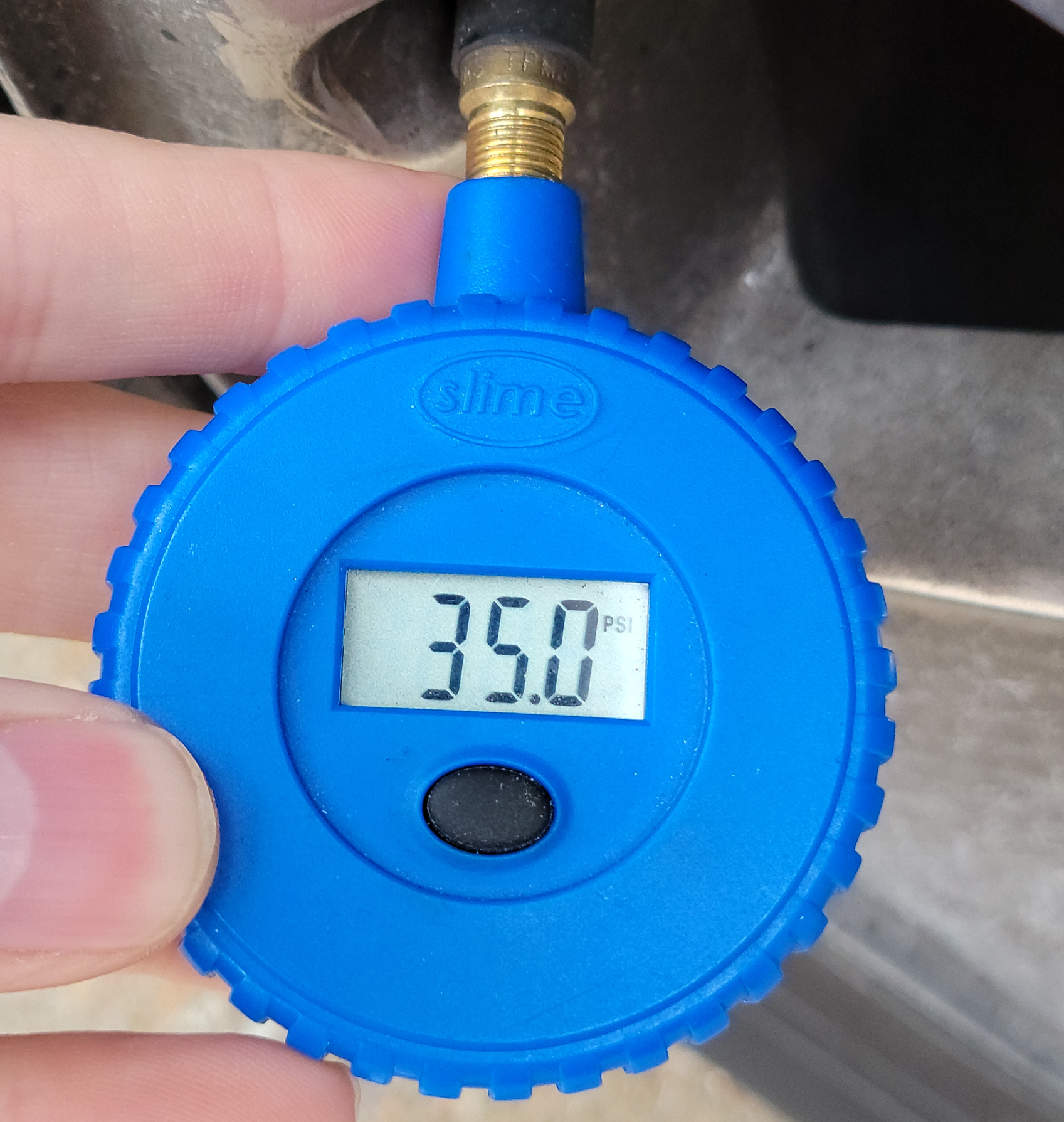Schrader-EG53MA4 off by 7%
Kevin Saye



Christian Z.
Kevin Saye
84 31.5
86 32.6
82 30.5
84 31.5
93 33.7
86 32.6
93 33.7
90 32.6
91 32.6
Christian Z.
Greg Troxel
"Christian Z." <chri...@zuckschwerdt.org> writes:
> There should be a quite visible difference in measured pressure in relation
> to temperature.
> https://en.wikipedia.org/wiki/Gay-Lussac%27s_law
> But I'm not sure if a sensor compensates for that or if a head unit /reader
> would do that.
temperature and thus the pressure goes up and down with temperature.
Some vehicles display pressure on the dash.
> If the manual measured PSI is 35 and the report from the sensor is 32, then
> maybe the sensor reports compensated for a fictional lower temperature?
> Does not seem likely though.
> Support was added with https://github.com/merbanan/rtl_433/pull/624 some 4
> years ago. And the pressure unit assumed to be 25mBar per bit. Not sure if
> it's just a guess though.
which sensor | sensor raw value | gauge reading | sensor raw temperature value | ambient temp
obtained when the vehicle is in a garage (not in sun) and has not been
driven) and try to construct a calibration.
If there is any info from the car about received values, that would be
very interesting.
It's important to separate out a sensor that reads high or low from an
error in converting bits to pressure. So it would be nice to have the
log above cover 4 different sensors.
Philip Knowles
I understand it as Charles’ Law but, if the temperature is measured, it is possible to ‘correct’ the indicated pressure to that at a nominal 20C. It should really do that as otherwise you would never really know if the tyre pressure was ‘correct’ – under inflated in winter and over inflated in summer.
Sent from Mail for Windows
--
You received this message because you are subscribed to the Google Groups "rtl_433" group.
To unsubscribe from this group and stop receiving emails from it, send an email to rtl_433+u...@googlegroups.com.
To view this discussion on the web, visit https://groups.google.com/d/msgid/rtl_433/rmibkxzxdro.fsf%40s1.lexort.com.
Greg Troxel
> I understand it as Charles’ Law but, if the temperature is measured, it
> is possible to ‘correct’ the indicated pressure to that at a nominal
> 20C. It should really do that as otherwise you would never really know
> if the tyre pressure was ‘correct’ – under inflated in winter and over
> inflated in summer.
reporting:
1) actual pressure and temperature, and the car decides if that is ok
vs
2) pressure corrected to some standard conditions (20C, 25C)
It seems that TPMS is design 1.
There's a further question, which is if a tire that is supposed to be
inflated to 2.5 bars is supposed to be at that pressure when
a) at some standard 20 or 25 C
b) at the average outdoor temperature for the season
In other words, for a theoretical tire with no loss of air, should you
be adjusting it between an average outdoor temperature of say -5C and 15C?
Philip Knowles
Yes, but the standard reference temperature is 20C (which is probably what the tyre manufacturer would base it on) so it should use your type 2 otherwise it’s a bit pointless. Standard manufacturer handbook instructions say to measure tyre pressures ‘cold’ so not compensating for temperature could be potentially dangerous. On a very cold winter’s day the tyre pressure might appear to be very low, say 6psi below normal, so the driver inflates the tyre. They then drive a long distance and, in theory, the tyre pressure could then exceed the maximum tyre pressure. As I understand it TPMS don’t warn on over inflation.
Sent from Mail for Windows
From: Greg Troxel
Sent: 21 March 2022 22:14
To: Philip Knowles; Christian Z.; rtl_433
Subject: Re: [rtl_433] Re: Schrader-EG53MA4 off by 7%
On 3/21/22 6:09 PM, Philip Knowles wrote:
Greg Troxel
> Yes, but the standard reference temperature is 20C (which is probably
> what the tyre manufacturer would base it on) so it should use your type
> 2 otherwise it’s a bit pointless. Standard manufacturer handbook
> instructions say to measure tyre pressures ‘cold’ so not compensating
> for temperature could be potentially dangerous. On a very cold winter’s
> day the tyre pressure might appear to be very low, say 6psi below
> normal, so the driver inflates the tyre. They then drive a long distance
> and, in theory, the tyre pressure could then exceed the maximum tyre
> pressure. As I understand it TPMS don’t warn on over inflation.
We agree that one needs to evaluate pressure at some standard temp when
determining if the current situation is ok, more or less But it does NOT
follow from that idea that a TPMS will transmit a pressure corrected to
a standard temp. I believe most transmit an actual pressure and a
temp, and the computer in the car does the math and decides to alert.
Reading the internet for advice, the standard approach seems to be to
inflate to the placard pressure first thing in the morning before
driving, which means a greater absolute amount of air in the winter
compared to summmer. That makes sense to me; while there is temp rise
from driving, the absolute temps after an hour of high-speed driving
will be less in winter than summer.
Yes, if you inflate to standard pressure some morning at -20C, and then
drive to a 30C place that day and drive 150 km/hr for multiple hours,
that could be too much inflation. But that doesn't bear on a system
design choice to report corrected pressure vs reporting pressure and
temperature.
I would want P/T separately, so that I could also alert on excessive
temperature. But that isn't an argument that someone else must have
done that.
If you have a a reference that says what various TPMS sensors actually
report that would be very interesting.
